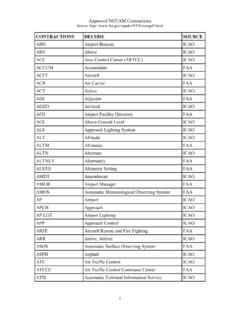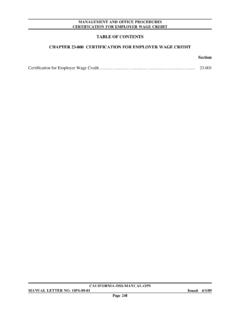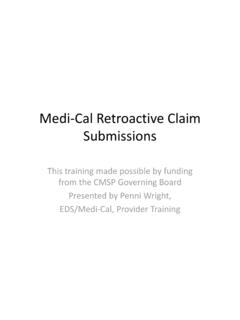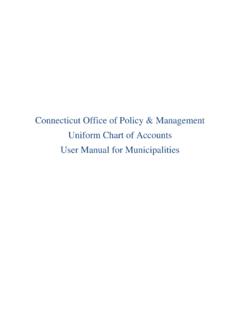Transcription of NORTH ATLANTIC MNPSA OPERATIONS MANUAL …
1 NORTH ATLANTIC MNPSA OPERATIONS MANUAL CHAPTER 12 NAT MNPS 73 Edition 2009 Other issues 1. Contingencies (a) Published Weather Deviation Procedure (b) 15 NM offset (formerly 30NM in the NAT, 25NM in the Pacific) (c) Lost Comm/NAV Procedures 2. ETOPS 3. Weather Destination/Alternate(s) Airport(s) 4. Data Link Contingency Procedures 5. Dead Reckoning (DR) 6. GPS RAIM/FDE Requirements Expanded checklist The detail of the check items listed above and the rationale for their inclusion follow. Flight planning Plotting chart A plotting chart of appropriate scale should be used for all remote oceanic OPERATIONS . This includes using a plotting chart for published oceanic routes and tracks. ICAO groups who review oceanic errors have determined that the routine use of a plotting chart is an excellent aid to reduce lateral errors.
2 A plotting chart can also serve as a critical aid in case of partial or total navigation failure. It should be noted that the pilot should read from the plotting chart back to the master CFP when verifying data. To read from the master CFP to the plotting chart is a human factor s issue that has lead to errors based on seeing what we expect to see Equal Time Point (ETP) ETPs should be computed for contingencies such as medical divert, engine loss or rapid depressurization. A simultaneous engine loss and rapid depressurization should also be considered. It is advisable to note the ETPs on the plotting chart . Crewmembers should review with each other the appropriate diversion airport(s) when crossing ETPs. Pilot procedures should also include a MANUAL method for computing ETPs.
3 Crews should not enter ETPs in the Long Range Navigation System (LRNS) as this has led to Gross Navigation Errors. Track message Crews must have a current track message even if filed for a random route. Reviewing the date, effective Zulu time and Track Message Identifier (TMI) ensures having a current track message on board. The TMI is linked to the Julian Date. Operators must also ensure that their flight planning and operational control process notify crewmembers in a timely manner of any amendments to the daily track message. Plotting tracks near the assigned route can help situational awareness in case the crew needs to execute a contingency. Review possible navigation aids for accuracy check prior to coast out It is good practice to discuss in advance a primary and secondary ground based navigational aid that will be used to verify the accuracy of the LRNS.
4 This planning may help to identify intended navigation aids that are limited or NOTAMed unusable and is helpful when departing airports close to oceanic airspace. Examples include Shannon (EINN), Lisbon (LRRT), Los Angeles (KLAX), etc. Preflight master Clock It is a requirement to have a master clock on board synchronized to UTC or GPS. This time source, which is typically the Flight Management System (FMS), must be used for all ETAs and ATAs. The use of multiple time sources on the aircraft has lead to inconsistencies in reporting times to ATC and resulted in a loss of longitudinal separation. NORTH ATLANTIC MNPSA OPERATIONS MANUAL CHAPTER 12 NAT MNPS 74 Edition 2009 Maintenance Log Before entering a special area of operation, crews should focus on any write-ups that affect communication, navigation, surveillance or RVSM requirements.
5 Any discrepancies noted in the maintenance log or during the walk-around may require delays or rerouting. RVSM Required equipment includes two primary independent altimetry sources, one altitude alert system and one automatic altitude control system. In most cases a functioning transponder that can be linked to the primary altimetry source is also required. Crews should note any issues that can affect accurate altimetry. Altimeter checks Before taxi, crews should set their altimeters to the airport QNH. Both primary altimeters must agree within + 75 feet of field elevation. The two primary altimeters must also agree within the limits noted in the aircraft operating MANUAL . Wind Shear or Turbulence Forecast The master Computer Flight Plan (CFP) with projected wind shear or the turbulence forecast documents should be reviewed for flights in RVSM airspace.
6 Forecast moderate or greater turbulence could lead to RVSM suspension. Operators are cautioned against flight planning through areas of forecast moderate or greater turbulence. Computer Flight Plan (CFP) The document designated as the master CFP should be carefully checked for date, type aircraft, fuel load and performance requirements. Crosschecks should also be done for routing and forecast groundspeeds. The CFP should be carefully checked against the ICAO filed flight plan to ensure the routing is in agreement with both documents. The enroute time on the CFP should be compared against the distance to destination for a reasonable groundspeed. The enroute time should also be compared against the total distance for a reasonable fuel load. Dual Long Range NAV System (LRNS) Two operational LRNSs are required for remote oceanic OPERATIONS .
7 A single FMS is not authorized for remote oceanic OPERATIONS . HF check An HF check should be conducted on the primary and secondary HF radios in areas where dual HF radios are required. If possible, the HF checks should be done on the ground or before entering oceanic airspace. A SELCAL check should also be accomplished at each Oceanic Control Area (OCA) boundary. Confirm Present Position coordinates Both pilots should independently verify the present position coordinates using either published ramp coordinates or determine position from the airfield diagram. They should not rely solely on the present position when the LRNS was shut down from the previous flight. A master source such as an enroute chart should also be used to confirm accuracy of coordinates at the oceanic boundaries.
8 master CFP symbols Operators are encouraged to use consistent symbology on the master CFP. For example, a circled number ( O ) means the second crewmember has independently verified the coordinates entered or crosschecked by the first crewmember. A checkmark ( V ) may indicate that the track and distances have been confirmed. A diagonal line ( \ ) may indicate that the crew has confirmed the coordinates of the approaching and next way point. An X-symbol ( X ) may indicate having flown overhead the way point. NORTH ATLANTIC MNPSA OPERATIONS MANUAL CHAPTER 12 NAT MNPS 75 Edition 2009 LRNS programming - Check currency and software version It is important to check the effective date of the database. Crews should note if the database is projected to expire during their trip.
9 Crews are discouraged from flying with expired databases. MELs may allow relief to fly with an expired database but require the crews to manually crosscheck all data. The software version of the database should also be confirmed in case there has been a change. - Independent verification It is critical that one crewmember enters waypoint coordinates and that these are independently checked by another crewmember. It should be noted that the pilot should read from the FMS screen back to the master CFP when verifying data. To read from the master CFP to the FMS is a human factor s issue that has lead to errors based on seeing what we expect to see. - Check expanded coordinates of waypoints Most FMSs allow entering abbreviated oceanic coordinates. There have been cases when there was an error in the expended waypoint coordinate, but crews only checked the abbreviated coordinate.
10 Verifying only the abbreviated coordinate could lead to a lateral error. Flight crews should conduct a magnetic course and distance check between waypoints to further verify waypoint coordinates. - Track and distance check To minimize oceanic errors, it is important to conduct a magnetic course and distance check from oceanic entry to oceanic exit. Operators should establish a tolerance such as + 2o and + 2NM. The course and distance check comparing the master CFP against the LRNS are critical in detecting errors that may not have been noticed by simply checking coordinates. A difference of more than 2o between waypoints may be due to a difference of the magnetic variation in the database versus the variation used in the master CFP. Any difference outside the + 2o or + 2NM should be rechecked and verified.










